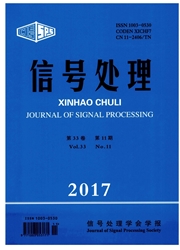

 中文摘要:
中文摘要:
三站频差定位是一种重要的无源定位方式,其典型的应用场景之一就是机载运动平台对固定辐射源的无源定位。为了给工程实践提供理论支撑,需要首先分析机载三站频差定位性能。鉴于此,本文首先描述了定位模型,包括频差观测方程、导航观测方程及地球表面约束条件。然后在考虑频差测量偏差及地心距偏差条件下,基于加权最小二乘准则,采用扰动法导出了辐射源位置估计均方误差的表达式,其表征了均方误差与各影响因素(载机速度、辐射源频率、频差误差、导航参数误差、地心距偏差等)的关系,可作为定位性能分析的依据。最后,通过算例仿真,在典型参数条件下分析了多种因素对定位性能的影响,得到了若干结论,并进一步指出了所获结论可能的实际应用价值。
 英文摘要:
英文摘要:
Triple-observer source localization using frequency difference of arrival(FDOA) measurements is an important passive localization method.One of the typical application scenarios is triple-aircraft passive localization of the fixed emitter.In order to support engineering effectively,it is necessary to assess the performance of triple-aircraft passive localization.Therefore,the localization models are firstly established,including the FDOA observation equations,navigation observation equations and earth surface constraint condition.And then,with the bias of FDOA and that of range between the emitter and the earth's core(REEC),the expression of the mean square error(MSE) of the emitter' s position is deduced by perturbation method according to weighted least squares(WLS) principle. The expression shows the relationship between MSE and relative factors,such as the velocity of the aircrafts,the frequency of the emitter,the error of FDOA,the error of navigation parameters,the bias of REEC and so on.Finally,with the typical simulation parameters, the influence of multiple factors on the localization performance is analyzed by simulation.Several conclusions are obtained and their possible practical values are indicated in the paper.
 同期刊论文项目
同期刊论文项目
 同项目期刊论文
同项目期刊论文
 期刊信息
期刊信息
